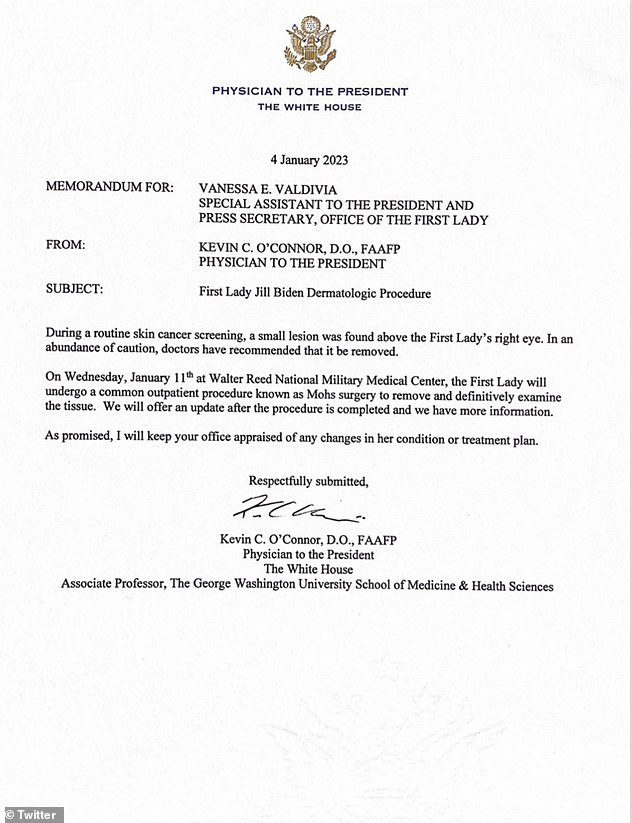Jill Biden, 71, to undergo preventative skin cancer surgery Mohs – but what Is the procedure like?
>
First Lady Dr Jill Biden, 71, is slated to undergo a common surgical procedure that successfully removes tumorous skin tissue in 99 per cent of all cases.
The White House physician announced last week that the executive branch’s medical team had found a ‘small lesion’ above the First Lady’s right eye.
Dr. Kevin O’Connor, Physician to the President, said that doctors at Walter Reed National Military Medical Center would extract the cancer ‘in an abundance of caution.’
The procedure, called Mohs surgery, is used to remove certain types of skin cancers including some melanomas, basal cell carcinoma, squamous cell carcinoma, and other less common skin cancers.
The news of her procedure comes just a couple of years after Dr Biden underwent ‘a common medical procedure’ at George Washington University Hospital though the purpose for the procedure was not disclosed by the White House.

Dr Jill Biden, 71, went to Walter Reed Military Medical Center on Wednesday to a cancerous skin leasion abover her right eye removed. She will undergo a Mohs procedure, which successfully excises skin cancers in 99 per cent of cases


Letter from the office of the Physician to the President to Press Secretary to the First Lady and Special Assistant to the President Vanessa Valdivia regarding Jill Biden’s Health Jan 3 2022During a routine skin cancer screening, a small lesion was found above the First Lady’s right eye. Memo here from Dr. Kevin O’Connor, Physician to the President, with more information on the First Lady’s upcoming outpatient procedure to have it removed and examined.https://twitter.com/vvaldivia46/status/1610778481264295936/photo/1
Dr Biden and her husband the president arrived at the hospital on Wednesday morning at around 8am. The White House is expected to issue an update on the First Lady’s condition in the afternoon.
Mohs surgery is performed in an outpatient setting and typically takes a few hours. Dr Biden will be awake for the surgery, which requires just local anesthesia to numb the area.
The objective is to excise as much cancerous skin tissue as possible while also doing as little damage to the surrounding healthy tissue as possible. It’s a gradual process and layers of skin are removed in steps.
First, the surgeon uses a scalpel to remove the surface level cancerous skin tissue with the understanding that there might be more cancerous tissue beneath the surface. Skin cancer is like an ice berg. The bulk of it is usually hidden under the surface.
The surgeon will map out where on the body the cancerous tissue was extracted, take that tissue sample to the lab, dye it, and cut it into sections. Specialized technicians place those tissue samples on slides to be investigated under the microscope.


Dr Biden and her husband Joe arrived at Walter Reed at approximately 8am on Wednesday. The procedure is straightforward and relatively quick. The White House will issue an update on Dr Biden’s condition later on Wednesday
The doctor painstakingly examines the edges of each section of tissue for evidence of remaining cancer. If the surgeon finds cancer cells under the microscope, their location is marked on the map.
The process is repeated until the doctor can find no evidence of cancer in the sampled tissue.
Some wounds will be big enough to require sutures to close. They typically heal within a couple of weeks. Smaller wounds can heal by themselves in about a month.
Typically people are able to leave between two and six hours after the outpatient surgery, though the timing depends on the size of the area effected.
The procedure is extremely common. Mohs surgery is performed on over 876,000 tumors per year in the United States.
Certain types of skin cancers treated by this procedure – basal cell and squamous cell carcinomas – are on the rise. Roughly 1.8 million cases of squamous cell carcinomas are reported annually. Over the past 30 years, incidences of squamous cell carcinomas have spiked 200 per cent, according to the Skin Cancer Foundation.
Basal cell carcinoma, meanwhile, is the most common form of skin cancer and the most frequently occurring form of all cancers. An estimated 3.6 million cases are diagnosed each year in the U.S. alone.
The rising rates of skin cancer are likely due to better detection and diagnosis capabilities as well as increased exposure to ultraviolet light, more time spent on outdoor activities, changes in clothing style, increased longevity, ozone depletion, genetics and in some cases, immune suppression.
